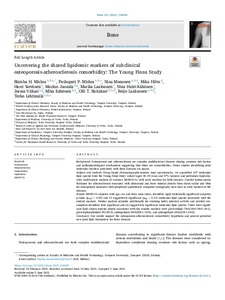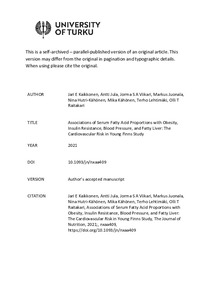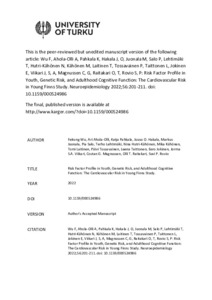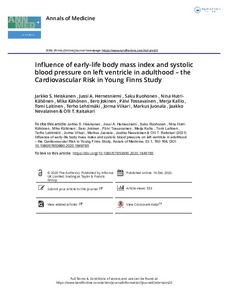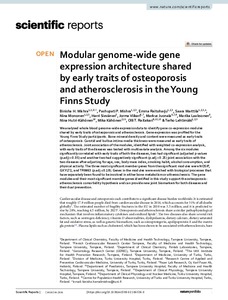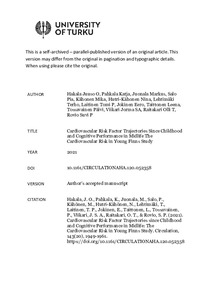Hae
Aineistot 1-10 / 10
Uncovering the shared lipidomic markers of subclinical osteoporosis-atherosclerosis comorbidity: The Young Finns Study
<p>Background: Osteoporosis and atherosclerosis are complex multifactorial diseases sharing common risk factors and pathophysiological mechanisms suggesting that these are comorbidities. Omics studies identifying joint ...
Childhood and Adulthood Passive Smoking and Nonalcoholic Fatty Liver in Midlife: A 31-year Cohort Study
INTRODUCTION: Identifying early life risk factors remains key to the prevention of nonalcoholic fatty liver (hereinafter "fatty liver") in adulthood. However, the longitudinal association of childhood passive smoking with ...
IDO activity forecasts obesity in males and premenopausal females in a 10-year follow-up study:The Cardiovascular Risk in Young Finns Study
<p>Background and aims: Indoleamine 2,3-dioxygenase (IDO) is an intracellular enzyme associated with artery wall inflammation. Previous studies have verified correlation between IDO activity and early signs of atherosclerosis especially in females. We aimed to elucidate the relationship between an estimate of IDO activity and atherosclerotic risk factors related to non-alchohol-fatty liver (NAFLD) in a 6- and 10-year follow-up.<br></p><p>Methods: Estimates of IDO activity along with complete risk factor data were measured from females (n = 506; age 24-39) and males (n = 421; age 24-39) in 2001. Risk factor measurements were conducted again in 2007 and 2011. Statistical examinations were carried out by Pearson correlation and risk ratio analysis.<br></p><p>Results: In females, age-adjusted IDO correlated with body mass index (BMI) (p = 0.0008), waist (p = 0.0009), C reactive protein (CRP) (p = 0.0014) and logarithmically modified triglycerides (p = 0.0488) in 2007. Correlation remained significant with BMI (p = 0.0007) and waist (p = 0.0063) in 2011. In males, age-adjusted IDO correlated with waist (p = 0.0367) and high-density lipoprotein cholesterol (HDL-C) (p = 0.0489) in 2007. Correlation remained significant with HDL-C (p = 0.0348) in 2011. In risk ratio analysis, relationship between IDO and obesity was confirmed in females after 10 years (RR = 1.026, p = 0.0147, 95% CI) and in males after 6 and 10 years (RR = 1.019, p = 0.0091, 95% CI and RR = 1.015, p = 0.0404, 95% CI, respectively) when the data was adjusted for age and BMI.Conclusions: IDO activity correlated with obesity and factors related to NAFLD, namely obesity of visceral type, hypertriglyceridemia and CRP (in females), well-characterized risk factors for diabetes and atherosclerosis in 6 and 10-year follow-up in males and premenopausal females.</p>...
Association of lifetime blood pressure with adulthood exercise blood pressure response: the cardiovascular risk in young Finns study
<p>Purpose<br></p><p>Elevated blood pressure (BP) in childhood has been associated with increased adulthood BP. However, BP and its change from childhood to adulthood and the risk of exaggerated adulthood exercise BP ...
Associations of Serum Fatty Acid Proportions with Obesity, Insulin Resistance, Blood Pressure, and Fatty Liver: The Cardiovascular Risk in Young Finns Study
<p><strong>Background: </strong>The links between fatty acids (FAs) and cardiometabolic outcomes are topics of debate.</p><p><strong>Objective: </strong>Our aim was to investigate the associations between serum standardized ...
Risk Factor Profile in Youth, Genetic Risk, and Adulthood Cognitive Function: The Cardiovascular Risk in Young Finns Study
<p>INTRODUCTION</p><p>The role of risk factor profile in childhood and adolescence on adulthood cognitive function and whether it differs by genetic risk is still obscure. To bring this evidence, we determined cognitive ...
Childhood exposure to parental smoking and life-course overweight and central obesity
<p><strong>Objective: </strong>To evaluate the association between childhood parental smoking exposure and the risk of overweight/obesity from childhood to adulthood.</p><p><strong>Methods: </strong>This study leverages ...
Influence of early-life body mass index and systolic blood pressure on left ventricle in adulthood - the Cardiovascular Risk in Young Finns Study
<p>Background<br></p><p>Increased left ventricular mass (LVM) predicts cardiovascular events and mortality. The objective of this study was to determine whether early-life exposures to body mass index (BMI) and systolic blood pressure (SPB) affects the left ventricular structure in adulthood.<br></p><p>Methods<br></p><p>We used longitudinal data from a 31-year follow-up to examine the associations between early-life (between ages 6-18) BMI and SPB on LVM in an adult population (N = 1864, aged 34-49). The burden of early-life BMI and SBP was defined as area under the curve.<br></p><p>Results<br></p><p>After accounting for contemporary adult determinants of LVM, early-life BMI burden associated significantly with LVM (3.61 g/SD increase in early-life BMI; [1.94 - 5.28], p < 0.001). Overweight in early-life (age- and sex-specific BMI values corresponding to adult BMI > 25 kg/m<sup>2</sup>) associated with 4.7% (2.5-6.9%, p < 0.0001) higher LVM regardless of BMI status in adulthood. Overweight in early-life combined with obesity in adulthood (BMI > 30kg/m<sup>2</sup>) resulted in a 21% (17.3-32.9%, p < 0.0001) increase in LVM. Higher early-life BMI was associated with a risk of developing eccentric hypertrophy. The burden of early-life SPB was not associated with adult LVM or left ventricular remodeling.<br></p><p>Conclusions<br></p><p>High BMI in early-life confers a sustained effect on LVM and the risk for eccentric hypertrophy independently of adulthood risk factors.</p>...
Modular genome-wide gene expression architecture shared by early traits of osteoporosis and atherosclerosis in the Young Finns Study
We analysed whole blood genome-wide expression data to identify gene co-expression modules shared by early traits of osteoporosis and atherosclerosis. Gene expression was profiled for the Young Finns Study participants. ...
Cardiovascular Risk Factor Trajectories Since Childhood and Cognitive Performance in Midlife The Cardiovascular Risk in Young Finns Study
<b>Background: </b>Cardiovascular risk factors, such as high blood pressure, adverse serum lipids, and elevated body mass index in midlife, may harm cognitive performance. It is important to note that longitudinal accumulation ...
